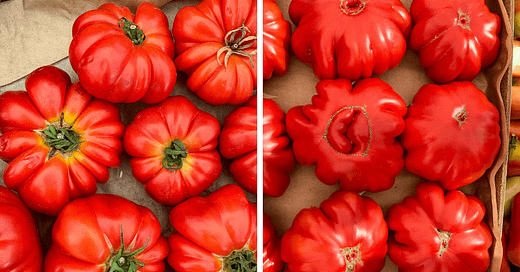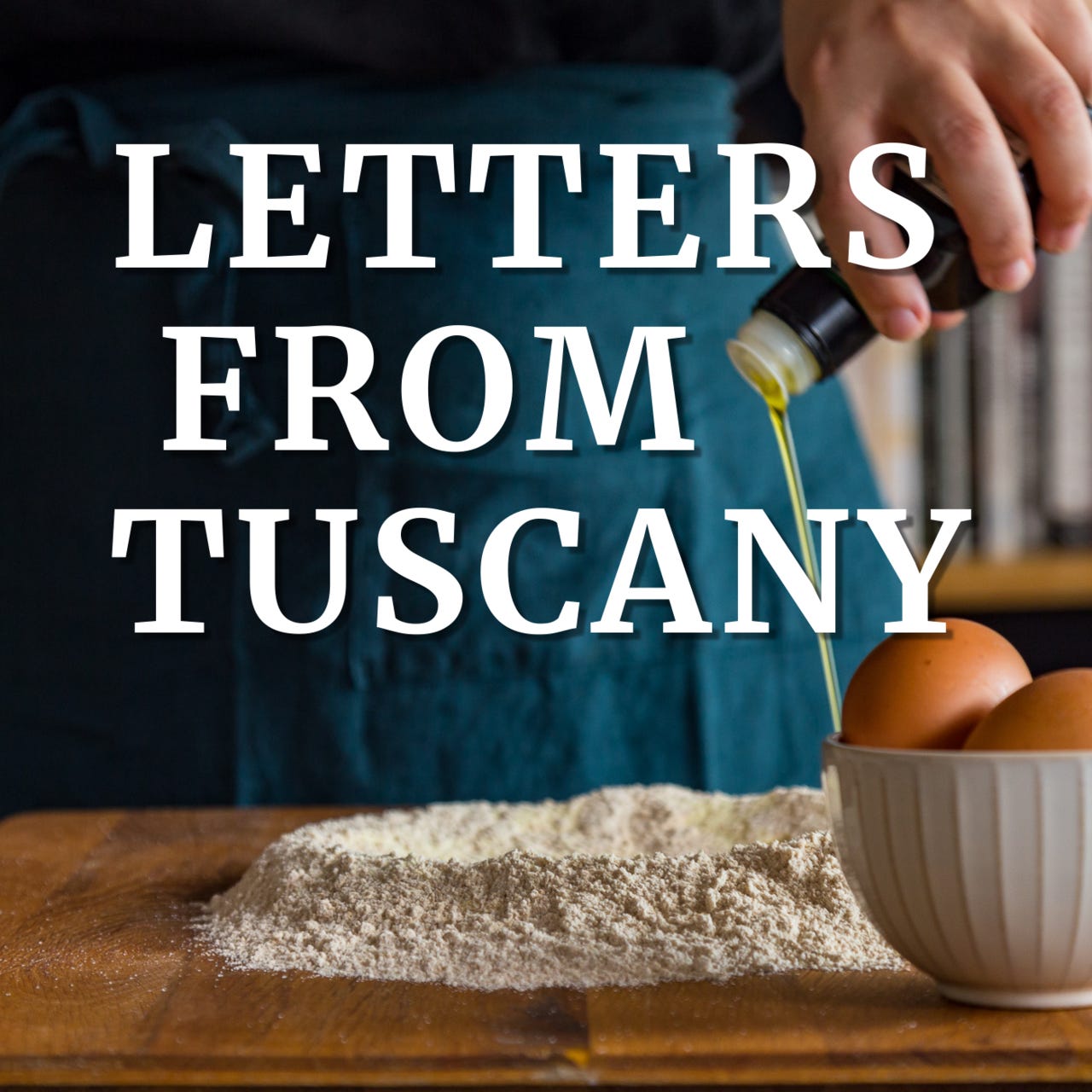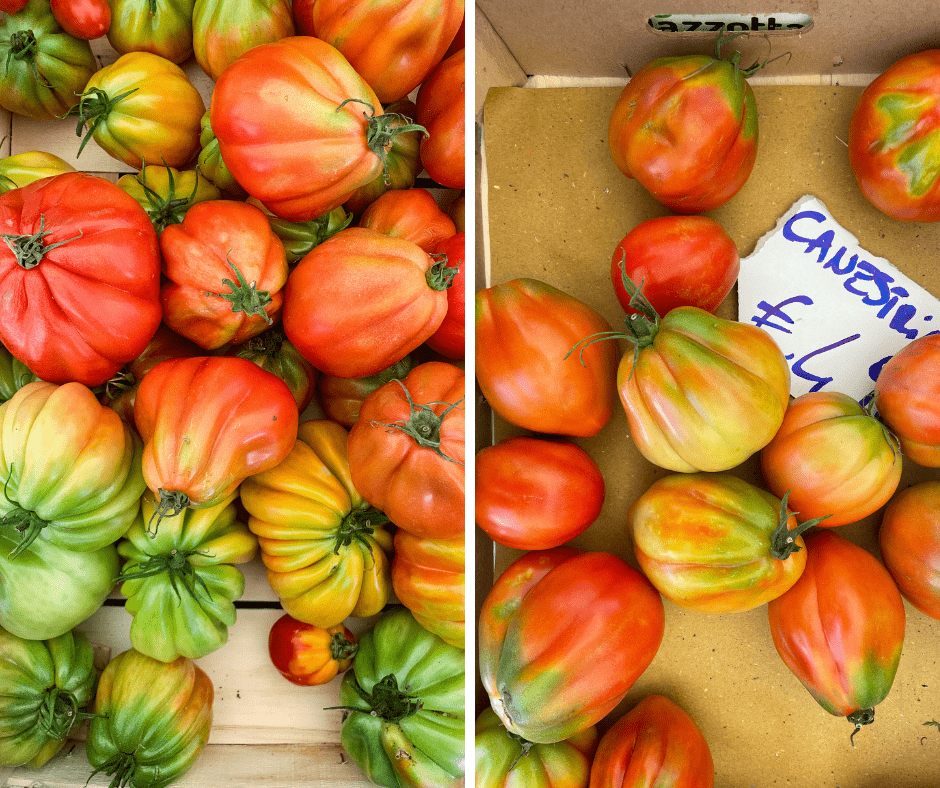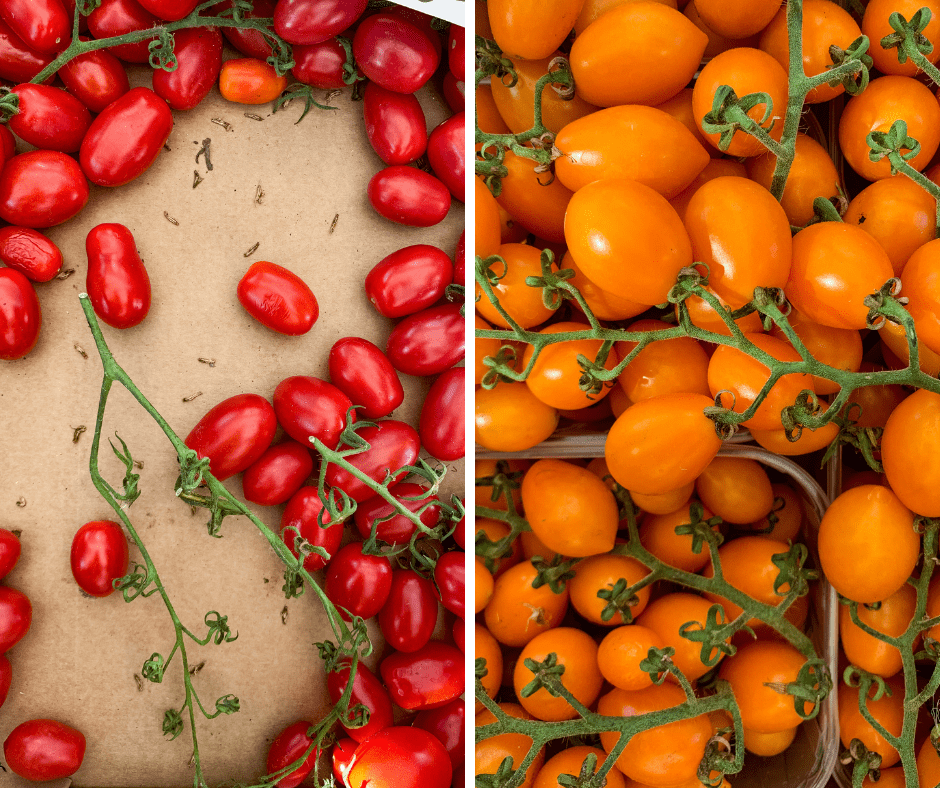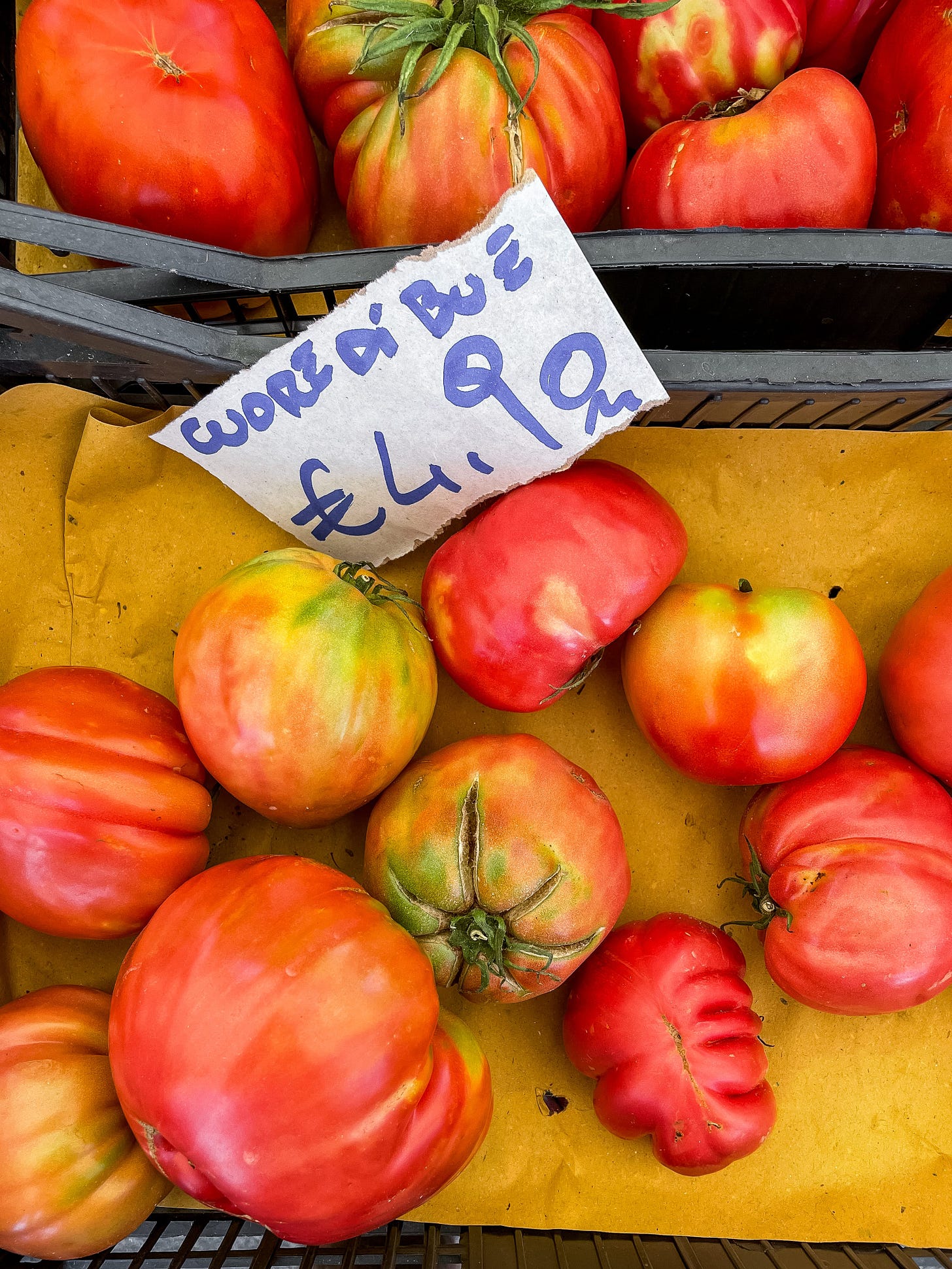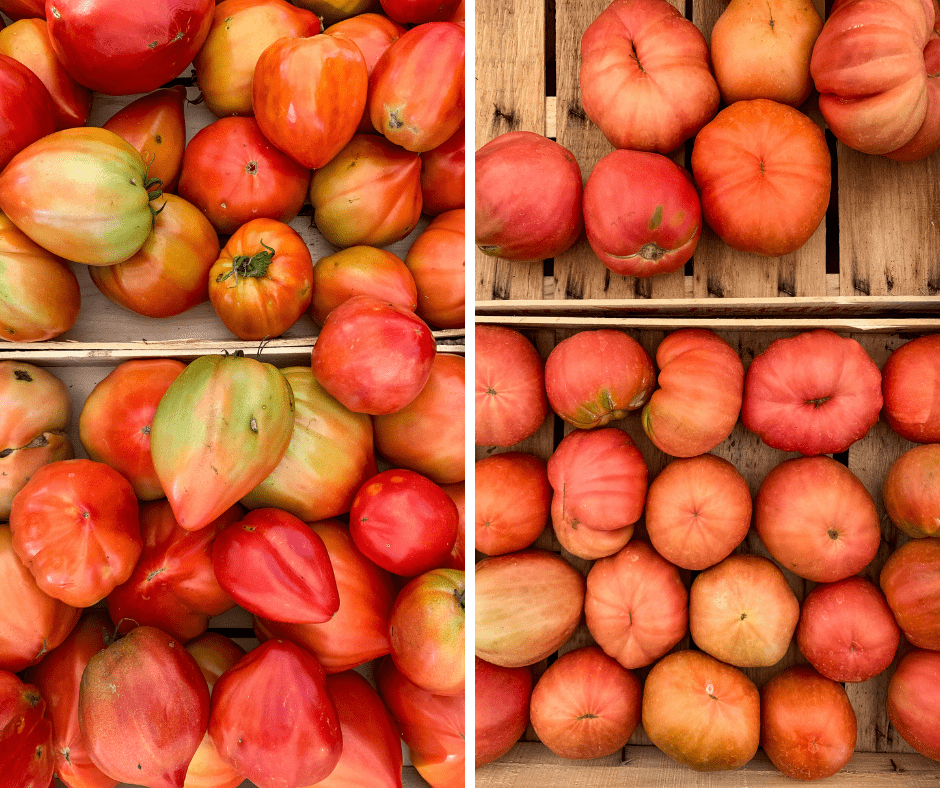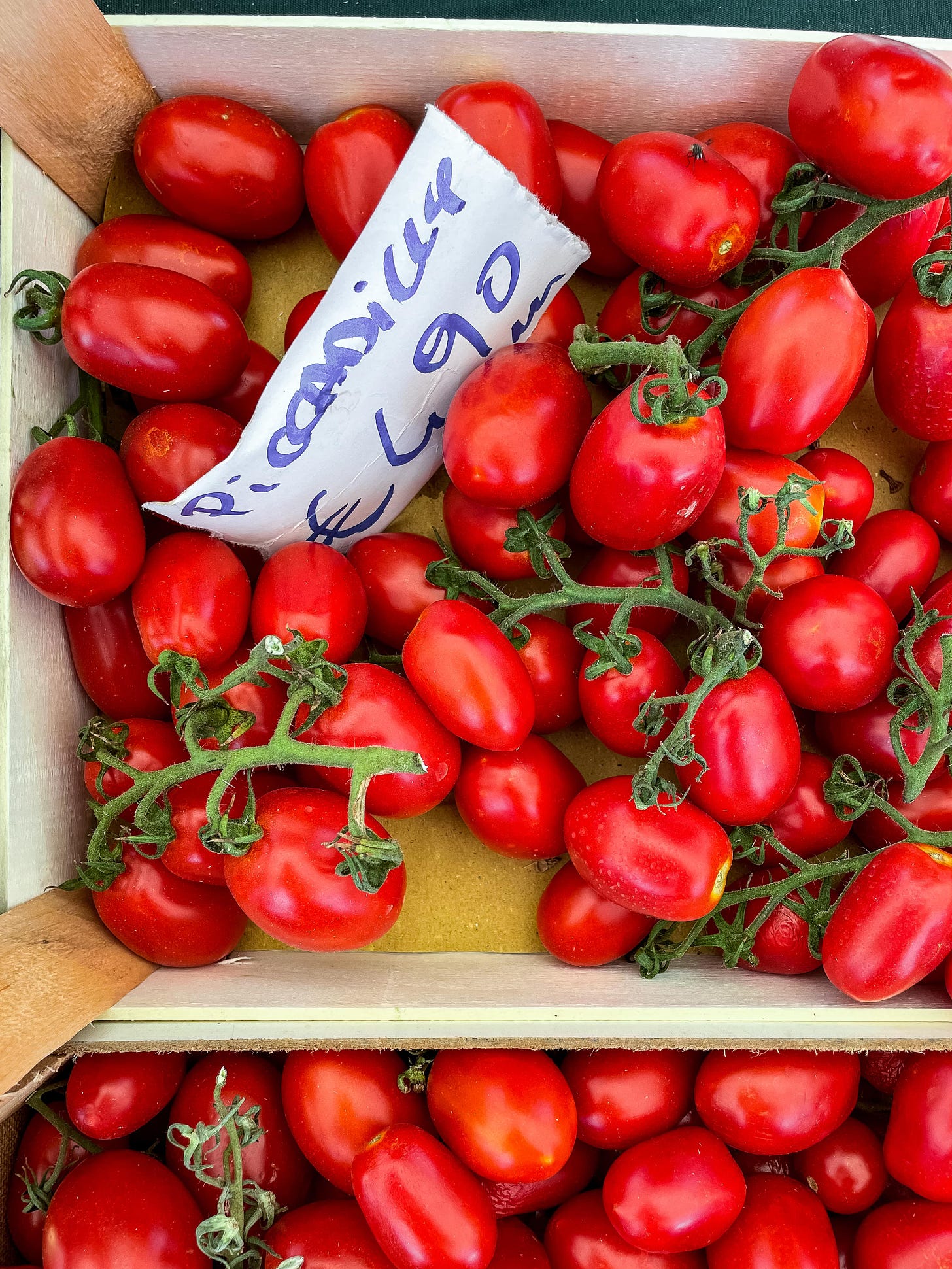Tomato varieties in a Tuscan market
Ciliegini, datterini, Costoluti Fiorentini, cuore di bue, Canestrini, San Marzano: all the tomato varieties, and the most delicious recipes you can make with them
Ciao a tutti, a quick announcement before this week’s post, a long-form all about tomatoes.
In the last few days, some of you have unsubscribed from this newsletter because you do not have time to read the content that Tommaso and I create.
I feel you. For those of you whose inboxes are clogged with Substack newsletters, you will surely really appreciate the new Substack app (I use it now more often and with much more pleasure than the Instagram App).
It’s a more focused reading/viewing experience. Audio and video play right in the app (yes, you can listen to our podcast, too!). Community features such as comments and discussion threads happen in the app. And last but not least, if you enable notifications on your device, you can opt out of receiving emails in your inbox but only via the app.
The Substack app is currently available for iOS. Substack for Android will be coming soon.
Thank you for the support, and now, to the tomatoes…
When we stop at the vegetable stall during a market visit in the summer, tomatoes in their many shades, shapes, and varieties steal the scene from all the other products.
Big, small, with a thick skin or with fewer seeds, bright red or slightly pink, firm to the touch or heavy, ready to become a sauce: we could talk for hours about the many varieties of tomatoes and how to use them in the kitchen.
Ciliegini, datterini, fiorentini, cuore di bue, canestrini, San marzano. Some of these tomatoes have names and surnames, others are defined by their origins, or by their shape: many more are the varieties you can grow in your garden, heirloom tomatoes whose seeds have been passed down from generation to generation.
“The tomato, ubiquitous in Italian cooking today, was not received with any notable enthusiasm. It had reached Italy at least by 1554, when a description of it was published under the name of pomo d’oro (it is pomodoro today, golden apple). The first tomato the Italians saw was indeed yellow, and not much larger than a cherry. It took two centuries for the Italians to decide to eat tomatoes, and even at that they were the first Europeans to take the risk.”
Waverly Root, The Food of Italy
Today I’m showing you around our local weekly market in Colle Val d’Elsa. These are the most common tomato varieties you could find in a Tuscan market at the peak of the tomato season.
Along with photos and a brief explanation of each variety, I’m also sharing the tips I gathered through the years, and the most delicious recipes you can make with them. Now, follow me…
Do you have a favourite variety of tomatoes? maybe a local one that you simply adore? let me know in the comments!
Costoluti Fiorentini
We had to start with Costoluti Fiorentini, probably the most representative tomatoes of the Tuscan summer. Costoluto Fiorentino is a local variety of ribbed tomatoes from Florence, heavy and juicy, with a sweet, aromatic pulp. These are my favourite tomatoes to use in any Tuscan recipe.
Use them to make pappa al pomodoro, to make my garlicky tomato sauce, and also to prepare this spicy tomato jam.
They are also my go-to tomato to make pane e pomodoro, the typical summer merenda, afternoon break, of Tuscan kids: halve the tomato, rub it on a slice of bread until it is nicely soaked with the juices and turns red, then drizzle with olive oil and season with salt and dried oregano.
Canestrino di Lucca
Another local variety of ribbed tomatoes is canestrino di Lucca, which owes the name to its shape, as it looks like a basket (canestro in Italian). When perfectly ripe, it is red with a green top, and deliciously sweet.
Enjoy canestrino di Lucca at its best when raw, maybe in a Caprese salad, or stuff them with breadcrumbs or rice.
Datterini
With the shape of a date (dattero, hence its name), this plum tomato has a perfect balance of sweetness and acidity. They come in different colours, making them a great tomato for bright, colourful salads. Livia eats them by the dozen, simply halved and drizzled with her nonno’s olive oil.
Roast them to make my tomato risotto, or for this roasted tomato soup. They make also a spectacularly sweet tomato sauce.
Ciliegini
Cherry tomatoes are just like cherries, you would eat them like candies. The most famous cherry tomato in Italy is pomodoro di Pachino Igp, from the east coast of Sicily. Not as sweet as the datterini, cherry tomatoes are just as versatile.
I use them to make my burst cherry tomato sauce. Consider also slow roasting them to turn them into an aperitivo, as for these crostoni.
Pomodori tondi a grappolo
Round, smooth, and not particularly charming or attractive, these use to be the average tomatoes available in supermarkets when I was growing up. Yet, they represent the typical Italian red tomato.
They are often used on bruschetta, minced raw on pasta dishes, or sliced in a sandwich. I like to stuff them with rice, as they do in Rome (check my friends Loreto and Nicoletta’s recipe), or with breadcrumbs.
Cuore di bue
Cuore di bue, ox heart tomato, is an heirloom variety that is large, heavy, with thin skin and fewer seeds than the average tomato. Eat it raw, in a salad dressed with olive oil, salt, and a shower of fresh basil, or chopped and spooned onto bruschette.
They are also my first choice when it comes to making panzanella, the summer Tuscan bread salad, and a seasonal pasta alla crudaiola, where the pasta is tossed with diced raw tomatoes.
These are also the tomatoes my friend Enrica Monzani would use to stuff with bread and cheese (here is her recipe).
Cupido and Ponderosa
This year I found two varieties of cuore di bue at the market: cupido (with a heart shape, bright red when ripe), and ponderosa (big, round, slightly ribbed, tinted in a delicate pink when ripe).
I slice both of them and alternate the slices on a platter. Dressed with extra virgin olive oil, rice vinegar, flaky sea salt, and plenty of fresh basil, they have been the hit of my summer cooking classes.
Piccadilly
Slightly bigger than datterini and smaller than San Marzano, Piccadilly tomatoes, known also as Vesuviani, are bright red, sweet, with a very thin skin, and therefore they are loved to make sauces.
I use them along with datterini to make my roasted tomato risotto and especially love them in my cherry tomato lasagna.
San Marzano
This is THE tomato used to make passata, pelati, and basically any tomato sauce. Use them to make passata, pomarola, and pelati, peeled tomatoes bottled just with a basil leaf. Compared to Roma tomatoes, San Marzano are thinner and more pointed, with fewer seeds and thicker flesh.
When still not quite ripe, I use them to make a tomato salad - as my father would appreciate - or halved and baked with some breadcrumbs.
Roma
The same variety of San Marzano tomatoes, even though less prized - and priced - Roma tomatoes have thicker skin, and therefore they are more resistant to diseases, making them the industry’s favourite tomato for sauce.
Usually, you can find them at a bargain at the market: buy at least a couple of kilos to make your favourite sauce.
Read more about Italian tomatoes here:
Tomato Tonnato
I’ve been eating tomato tonnato - or pomodori con la salsa tonnata, as I would call them - since I can remember. It was our lazy weeknight dinner while I was growing up, often prepared on a Monday if mum had made Vitello tonnato (roast veal smothered with tuna sauce) over the weekend.
We would grab a couple of tomatoes from the garden - dad has always been more partial to San Marzano, not too ripe, while I favoured cuore di bue -, slice them, and smother them in salsa tonnata. If we felt fancy, we would decorate the plate with brined capers and fresh basil, otherwise, we would just dress the sliced tomatoes directly onto our plates. Always serve them with some bread to mop the sauce bowl clean.
It was simple, unassuming food, made with seasonal vegetables and pantry staples, so I was stunned when I saw the recipe appear no less than in The New Yorker, in an article written by Helen Rosner, Tomato Tonnato Is the Sauce of the Summer.

